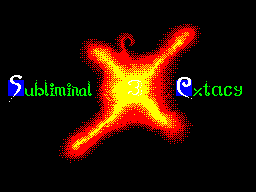|
Subliminal Extacy
#03
01 апреля 2001 |
|
Draw Routine with Bresenham Algorithms

Draw Routine with Bresenham Algorithms
Written by Mikezt
This article is dedicated to baze/Зsc.
One of the most basic graphic routines is a line draw. When you
try to write a draw routine you may find it a bit complicated.
Don't worry, here's one of way of doing it.
Bresenham algorithms have an advantage over methods because they
work with integer numbers. So they can be easily written in
machine code. Before we start, get ready for some mathematic
expressions. I'll write lower indexes in [].
Abscissa is defined with two points (x1, y1) and (x2, y2) and
can be written in the expression:
y = kx + q
where k is the direction and q is the shift on the y axis.
Direction k indicates inclination of the line and divide
coordination system to eight parts (see pic. 1). We get a
situation where k is positive and less than 1. Let's presume
that point (x[i], y[i]) was drawn. For each pixel we have to
compute the differences from the ideal course of abscissa
(pic. 2).
Difference of both possible points are:
D1 = y - y[i] = k * (x[i] + 1) + q - y[i]
D2 = y[i] + 1 - y = y[i] + 1 - k * (x[i] + 1) - q
Difference of these two values is equal to:
D = D1 - D2 = 2 * k * (x[i] + 1) - 2 * y[i] + 2 * q - 1
Along this difference we can choose the right point. It's clear
that the factor of decision is it's sign. A negative value will
select the point (x[i] + 1, y[i] + 1), and a positive one will
select (x[i] + 1, y[i]). The disadvantage is real character of
values. We can remove this disadvantage by multiply difference
expression by (x2 - x1) and we get the expression which is
called decision:
d[i]=D*(x2-x1)=2*(y2-y1)*(x[i]+1)-2*y[i]*(x2-x1)+(2*q-1)*(x2-x1)
and after a slight adjustment:
d[i]=2*(y2-y1)*x[i]-2*y[i]*(x2-x1)+2*(y2-y1)+(2*q-1)*(x2-x1)
Expression 2*(y2-y1)+(2*q-1)*(x2-x1) is constant and we indicate
it with c. so:
d[i] = 2 * (y2 - y1) * x[i] - 2 * y[i] * (x2 - x1) + c
Now this is an integer value, but it's quite complicated. If we
express decision for the next point we can write a recursive
relation. Here is decision for the next point:
d[i+1] = 2*(y2 - y1)*(x[i] + 1) - 2*y[i+1]*(x2 - x1) + c
After substracting these two decisions we can express the
decision value in a recursive form:
d[i+1] = d[i] + 2 * (y2 - y1) - 2 * (x2 - x1) * (y[i+1] - y[i])
Expression (y[i+1] - y[i]) can only store values 0 and 1 and we
can write modified expressions to compute decision:
d[i] < 0 => d[i+1] = d[i] + 2 * (y2 - y1)
d[ ] >= 0 => d[i+1] = d[i] + 2 * (y2 - y1) - 2 * (x2 - x1)
Last thing you need to know is the decision for the first step
and here is:
d[1] = 2 * (y2 - y1) - (x2 - x1)
So all you must do is check the decision for it's sign, if's
negative, move the y coordinate, compute decision for the next
step and test if you've drawn the last point. If not, do it all
again. For the other direction that 0 x1 (or any other one and choose variants with
this comparison) and if it's true then there's no change at
the start and end points.
- decision equations should be divided by 4 (two rotations) so
you can store it in an 8bit register, and no precision's lost.
Uf, that's all. My routine is available (I hope) on the HighTech
project (http://hightech.da.ru). I hope you understand what I've
tryed to say here. If not feel free to write to me. Bye!
mike/zt/ctl
jurica@sknet.sk
Другие статьи номера:
Похожие статьи:
В этот день... 30 декабря